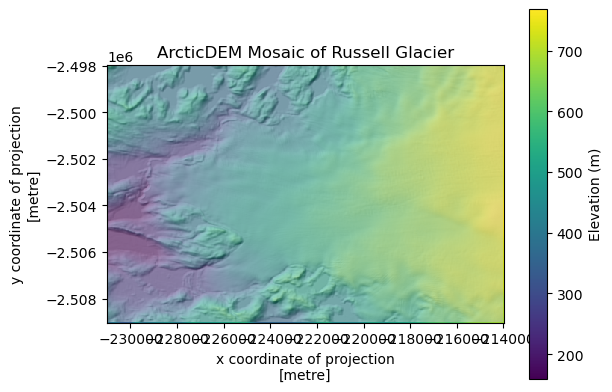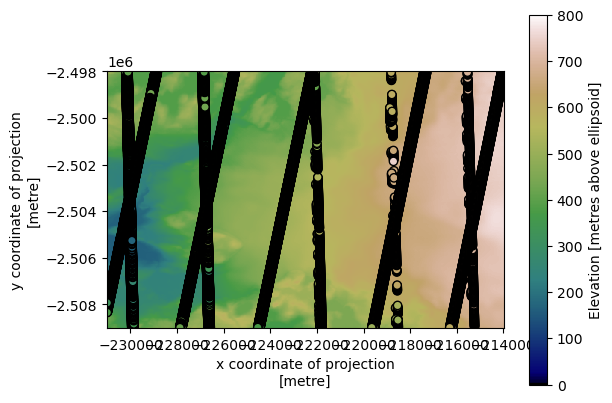10. Altimetry Data#
(specifically, ICESat-2)
This page is a Jupyter Notebook that can be found and downloaded at the GitHub repository.
Once again, there is no convenient STAC interface for altimetry data. The alternative is nearly as good though - the SlideRule tool has been developed for ICESat-2 (and GEDI) data, which allows you to generate ICESat-2 processed data on the fly.
import pdemtools as pdt
import geopandas as gpd
import pandas as pd
import matplotlib.pyplot as plt
from sliderule import sliderule, icesat2
from shapely.geometry import box
10.1. SlideRule Example#
Let’s examine another part of Greenland, and download a bit of the ArcticDEM mosaic for comparison.
russell_bounds = [-231000,-2509000,-214000,-2498000]
russell_gdf_3413 = gpd.GeoDataFrame(geometry=[box(*russell_bounds)], crs=3413)
russell_gdf_4326 = russell_gdf_3413.to_crs(4326)
dem = pdt.load.mosaic('arcticdem', 32, bounds=russell_bounds)
hillshade = dem.pdt.terrain('hillshade')
fig, ax = plt.subplots()
dem.plot.imshow(ax=ax, cbar_kwargs={'label': 'Elevation (m)'})
hillshade.plot.imshow(ax=ax, alpha=0.5, cmap='gray', add_colorbar=False)
ax.set_aspect('equal')
ax.set_title('ArcticDEM Mosaic of Russell Glacier')
Text(0.5, 1.0, 'ArcticDEM Mosaic of Russell Glacier')

Now, let’s show a quick example of how to download ICESat-2 ATL06 data from SlideRule.
# connect to sliderule
icesat2.init("slideruleearth.io")
# Turn the geodataframe into a sliderule-friendly object
sr_region = sliderule.toregion(russell_gdf_4326)
# set search parameters (apart from dates)
params = {
"poly": sr_region["poly"],
"t0": "2020-01-01", # Start date
"t1": "2020-12-31", # End date
"srt": 3, # Surface. 0-land, 1-ocean, 2-seaice, 3-landice (default), 4-inlandwater
"cnf": 1, # Confidence. Default 1 (within 10 m). 2: Low. 3: Medium. 4: High.
"ats": 20, # Mininum along track spread. SR Default: 20.
"cnt": 10, # Minimum photon count in segment. Default 10.
"len": 40, # Extent length. ATL06 default is 40 metres.
"res": 20, # Step distance. ATL06 default is 20 metres.
"track": 0, # Integer: 0: all tracks, 1: gt1, 2: gt2, 3: gt3. Default 0.
"sigma_r_max": 5, # Max robust dispersion [m]. Default 5.
}
is2_gdf = icesat2.atl06p(params).to_crs(3413)
n_points = len(is2_gdf)
print(f"Number of points found: {n_points}")
Warning, this environment is using an outdated client (v4.9.1). The code will run but some functionality supported by the server (v4.19.0) may not be available.
Number of points found: 18537
Now we have our ICESat-2 ATL06 data as a nice geodataframe:
is2_gdf.head()
| h_sigma | rgt | h_mean | w_surface_window_final | y_atc | n_fit_photons | dh_fit_dx | gt | spot | region | rms_misfit | x_atc | pflags | cycle | segment_id | geometry | |
|---|---|---|---|---|---|---|---|---|---|---|---|---|---|---|---|---|
| time | ||||||||||||||||
| 2020-01-10 09:35:06.322201600 | 0.039076 | 224 | 731.273062 | 3.000000 | 71.362442 | 118 | 0.046058 | 30 | 4 | 5 | 0.423777 | 12583511.0 | 0 | 6 | 628250 | POINT (-214005.561 -2498259.909) |
| 2020-01-10 09:35:06.325011200 | 0.057742 | 224 | 732.417008 | 3.881913 | 71.392601 | 121 | 0.055053 | 30 | 4 | 5 | 0.634964 | 12583531.0 | 0 | 6 | 628251 | POINT (-214009.553 -2498279.699) |
| 2020-01-10 09:35:06.327821824 | 0.048733 | 224 | 732.887001 | 3.435776 | 71.412392 | 131 | -0.016056 | 30 | 4 | 5 | 0.547110 | 12583551.0 | 0 | 6 | 628252 | POINT (-214013.559 -2498299.504) |
| 2020-01-10 09:35:06.330632960 | 0.025287 | 224 | 733.142206 | 3.000000 | 71.422310 | 135 | 0.048296 | 30 | 4 | 5 | 0.293369 | 12583571.0 | 0 | 6 | 628253 | POINT (-214017.574 -2498319.306) |
| 2020-01-10 09:35:06.333442816 | 0.035668 | 224 | 733.993594 | 3.000000 | 71.423027 | 105 | 0.034484 | 30 | 4 | 5 | 0.363403 | 12583592.0 | 0 | 6 | 628254 | POINT (-214021.598 -2498339.107) |
Let’s plot the data to the same colour scale as the ArcticDEM:
fix, ax = plt.subplots()
dem.plot.imshow(ax=ax, cmap='gist_earth', vmin=0, vmax=800, cbar_kwargs={'label': 'Elevation [metres above ellipsoid]'})
is2_gdf.plot(ax=ax, column='h_mean', cmap='gist_earth', vmin=0, vmax=800, ec='k', legend=False)
ax.set_title(None)
plt.show()

Great! Using the geodataframe, you may wish to perform tasks such as filtering to specific dates and crossover points. SlideRule also enables you to download other ICESat-2 derivative data.
